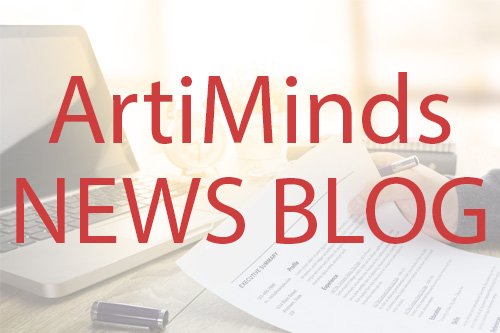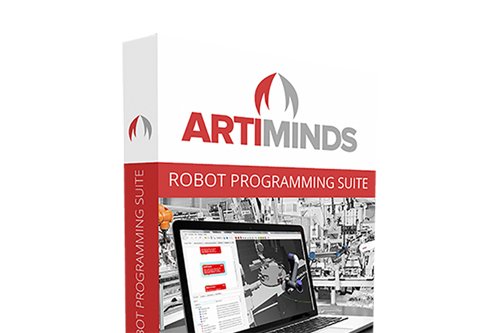ArtiMinds FAQ about ArtiMinds RPS & LAR
Frequently asked questions and answers
How does the installation work, which applications can I program with ArtiMinds or which interfaces does the software offer me? Find answers to these and many other questions in our FAQ section.
1. For whom is ArtiMinds suitable and which applications can be realized?
The ArtiMinds software solutions support anyone who wants to automate existing or new processes with robots. Our customers include large manufacturing companies, SMEs, system integrators, but also universities. As a result, ArtiMinds RPS and LAR are used in a wide variety of industries such as automotive, rail technology, aviation, industrial and consumer electronics, general industrial accessories, renewable energies, household appliances, medical technology, chemicals, furniture, packaging, clothing, and food. Assembly, electronic production, surface processing, quality assurance and control as well as handling are important and relevant types of applications for our customers.
2. Do I need robotics experience to use ArtiMinds?
No, experience with the programming of robots is not required. The aim of our software solutions is to simplify the programming of robots and hardware components, such as force-torque sensors, grippers and vision systems, and to shorten the process. Even if you have no special expert knowledge. With ArtiMinds, process experts become robotics experts.
The decisive advantage of the software is that you can program robot applications independently of the hardware and to transfer the program to all supported robot manufacturers. The complete focus lies on the existing process know-how. However, working with ArtiMinds does not replace safety training on the respective robot system!
3. Which technical requirements are necessary to work with ArtiMinds RPS & LAR?
A computer or notebook with at least the following specifications is recommended for ArtiMinds RPS:
- Operating system: Windows 10
- Processor: Intel or AMD, 2008 and newer
- Main memory: at least 8GB RAM
- Graphic card: NVIDIA GeForce 8800GT, ATI Radeon HD 2600
- Storage space: 15GB
A computer or server with at least the following specifications is recommended for ArtiMinds LAR:
- Operating system: Windows 10
- Processor: current quad core CPU
- Main memory: Depending on the number of robots and users. At least 16 GB RAM is recommended to get started
- Graphic card: –
- Storage space: Depending on the size of the database and the number of robot systems
Storage space: SSD hard disc storage depending on the size of the database and the number of robot systems.
If you are using a different operating system, please contact us >>GET IN CONTACT
4. Do existing robot applications in our company have to be adapted when using ArtiMinds?
No, the use of ArtiMinds in your company does not require any changes to your existing robot applications. Rather, ArtiMinds enables you to integrate robots into your production processes in an even more diverse and independent manner. Please contact us to find out how we can support you. >>GET IN CONTACT
5. Are both online and offline programming possible?
Yes, in ArtiMinds RPS online and offline programming merge seamlessly. In this way, you can start programming in the planning phase without a robot and simulate the application as well as carry out reachability analysis and collision checks. In the next step, individual points can be re-taught and adjusted on the real robot. Since the created program runs autonomously on the standard controller of the robot, no connection between the robot and ArtiMinds RPS is necessary after commissioning / during operation.
6. Which robots and peripheral hardware components does ArtiMinds support?
ArtiMinds supports numerous robot manufacturers and hardware components and the portfolio is continuously expanding. An overview of the robots and peripheral hardware components currently supported can be found >>HERE
If you use hardware that is not listed in the overview, please contact us >>GET IN CONTACT
In addition to robots, grippers, force-torque sensors and vision systems, direct communication with programmable logic controllers (PLC) is also supported.
7. Can reachability analysis be quickly realized?
Yes, reachability analysis can be carried out with the help of our three-dimensional simulation environment and the CAD2Path function in an easy way, allowing you to take the results directly into account for further programming and cell design.
8. Can cycle times be estimated quickly?
Yes, the simulation allows you to carry out initial cycle times estimation as soon as in the planning phase where you might not even have a real robot. After implementation and during operation, it is possible to use ArtiMinds LAR to analyze live data from the robot and e.g. to optimize cycle times.
9. We already have a PLC standard. Is it possible to communicate with the PLC via ArtiMinds RPS?
A robot program created with ArtiMinds RPS can communicate with a PLC via various communication protocols (Ethernet, Ethercat, Modbus, Profinet IO). This happens with our digital IO modules, with which e.g. BOOL or INT signals can be sent and received. This means that complex protocols such as a handshake for order processing can be programmed or data such as tray positions can be exchanged.
If the same protocol sections are used several times in the RPS program, it is not necessary to reassemble them each time. You can save and reuse them as a custom template.
If you already have a robot code for PLC communication, it can also be easily inserted into the RPS. In addition, it is possible to visualize fictitious PLC signals and the associated processes in the simulation.
10. How is the installation done and what is the effort involved?
The installation is carried out locally on the PC / laptop and is completed within a few minutes. It is identical to the installation of a conventional standard program. An installation wizard guides you through the installation so that no ArtiMinds employee has to visit you on site for commissioning.
11. Do I need training to work with ArtiMinds software?
No long intensive training is required to use ArtiMinds. You can learn the full scope of robot programming within just 2 days and later transfer this knowledge to various robot systems yourself. Since we have made the experience that training helps users getting started and being able to implement their projects more quickly and independently, the training is already included in our basic license by default. This means that there are no extra costs for the training. For more information click >>HERE: ArtiMinds Academy
12. How much effort does it take to configure a robot with ArtiMinds RPS?
The effort is very little! Using the integrated robot configurator, you can select your robot model and additional hardware components and thus define your individual setup. Thanks to the driver library in the software, the correct hardware connection is established automatically (drivers do not have to be created separately).
13. Is it necessary to connect the robot to the Robot Programming Suite during operation or can the program also be executed without RPS?
No, a connection to ArtiMinds RPS during operation is not necessary. The software generates native robot code that runs autonomously on the standard controller of the robot. For this reason, no additional hardware is needed in the robot cell.
If sensor and program data should be recorded with ArtiMinds LAR, the robot must be connected to the LAR server.
14. Can I save my projects, use them company-wide and use them on any workstation?
ArtiMinds RPS automatically saves projects in the form of a single, encrypted file that can be easily shared. In addition, the user can save self-developed processes as templates and reuse them in new projects.
We offer various license models for using the software. In addition to workstation-specific licenses, there is also the option of purchasing a server dongle license (“floating dongle”). If a server dongle is installed on a network computer, all workstations connected to this network can run ArtiMinds RPS.
15. I have a (ongoing) robotics project. How can I involve ArtiMinds in this project?
Our software solutions can be easily integrated into existing processes and projects, because with ArtiMinds RPS you do not necessarily have to create the complete robot program, but can only generate special sub-processes, while other parts are programmed “classically”. Besides that, ArtiMinds RPS is the right tool to introduce manufacturer-independent standards in robot programming at your company.
In addition, the team of the ArtiMinds Automation Engineering department with its many years of experience in robotics projects can advise you. From feasibility studies for critical process steps to solution-oriented project support, we are happy to help. >>CONTACT OUR TEAM
16. Can more complex and challenging applications such as assembly tasks or the processing of surfaces be realized with ArtiMinds RPS?
Yes, with ArtiMinds +Vision you can implement all applications that require a reaction to the results of image processing, e.g. such as pick and place. ArtiMinds +Force enables force-controlled, sensor-adaptive applications such as surface processing, joining, assembling, searching or aligning.
17. Is it possible to make subsequent changes directly to the robot program (in the programming language of the robot manufacturer) without ArtiMinds RPS?
Yes, this is possible at any time! ArtiMinds RPS generates native program code that runs on the standard controller of the robot manufacturer. This means that the program runs autonomously on the controller even without a connection to ArtiMinds RPS and can be changed at any time in the native programming language. ArtiMinds also offers the option of integrating native program code as a library or encapsulated in code templates into the RPS program.
18. I need an interface to a certain software environment. Does ArtiMinds for example support ERP or quality assurance software?
ArtiMinds has an HTML interface that can be used to connect other systems to RPS. For details, please contact our support >>GET IN CONTACT
19. Which additional software/technology packages from my robot manufacturer do I need if I want to use ArtiMinds software?
To use the ArtiMinds software solutions, technology packages from the respective robot manufacturers may be required. Download this >>PDF to check which additional software for which ArtiMinds module will be needed from the respective robot manufacturer.
Program and simulate robot applications independent of manufacturers, reduce maintenance costs and alleviate the lack of skilled workforces. Find out how ZF succeeds thanks to ArtiMinds!
In our robotics blog you will find the latest news and topics from industry and ArtiMinds.
Learn more!
MUCH MORE THAN JUST SIMPLE ROBOT PROGRAMMING: With RPS you create cross-process standardization – from planning and programming to maintenance.




